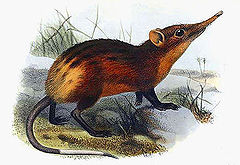Golden-rumped sengi: Difference between revisions
m robot Adding: mt:Senġi ta' taħt dahru dehebi |
|||
| Line 26: | Line 26: | ||
==References== |
==References== |
||
POOPY |
|||
* [http://news.bbc.co.uk/2/hi/science/nature/6263331.stm News story about the Evolutionarily Distinct and Globally Endangered project (EDGE)] |
|||
* {{IUCN2006|assessors=FitzGibbon & Rathbun|year=2006|id=19705|title=Rhynchocyon chrysopygus|downloaded=11 May 2006}} Database entry includes justification for why this species is endangered |
|||
*The Kingdom Field Guide to African Mammals ''by'' Jonathan Kingdom, [[1997]]; ISBN 0-7136-6513-0 |
|||
*The New Encyclopedia of Mammals, ''edited by'' David Macdonald, Oxford University Press, [[2001]]; ISBN 0-19-850823-9 |
|||
*{{MSW3 Schlitter|pages=84}} |
|||
==External links== |
==External links== |
||
Revision as of 19:26, 8 March 2007
| Golden-rumped Elephant Shrew | |
|---|---|

| |
| Scientific classification | |
| Kingdom: | |
| Phylum: | |
| Class: | |
| Order: | |
| Family: | |
| Genus: | |
| Species: | R. chrysopygus
|
| Binomial name | |
| Rhynchocyon chrysopygus | |
The Golden-rumped Elephant Shrew, Rhynchocyon chrysopygus, is the largest of all the unique African family, the elephant shrews. It is the size of a small rabbit, and is only found in the coastal Arabuko Sokoke National Park north of Mombassa in Kenya. Its name is dervived from the conspicuous golden fur on its hindquarters which contrasts strongly with its otherwise dark fur. On juveniles its fur shows vestigal traces of the checkerboard pattern seen on another giant elephant shrew, the Checkered Elephant Shrew (Rhynchocyon cirnei).
The Golden-rumped Elephant Shrew lives on the forest floor of evergreen forests, rooting through the leaf litter for 80% of the waking day looking for grasshoppers, beetles, spiders and other small invertebrates.
The Golden-rumped Elephant Shrew has evolved various stratagems to avoid predators, particularly snakes (like Black Mambas and cobras) and Southern Banded Harrier Eagles. It is very fast, capable of running at 25km/h. In the event of it detecting a predator within its 'flight distance' it will bound off. If, however, the predator is outside its flight distance the elephant shrew will advertise its presence by slapping the leaf litter. This lets the predator know that it has been seen and it should not waste its time chasing the elephant shrew. In the event of a chase, or an ambush, the golden flash of fur will also often deflect the predators attention away from the head and onto the rump, which has thickened skin. As a final precaution each shrew has several nests which it maintains, thus a predator finding a nest will not learn to associate them with potential food.
The Golden-rumped Elephant Shrew is considered vulnerable because of its highly restricted range (it is endemic to one forest); it is also hunted for food and by feral dogs.
References
POOPY
External links
- EDGE of Existence (Rhynchocyon chrysopygus) - Saving the World's most Evolutionarily Distinct and Globally Endangered (EDGE) species
